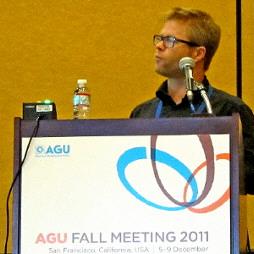Posted 16 December 2011

Dr Andersen at the AGU Fall Meeting 2011
Groundwater researchers from the CWI team attended the annual American Geophysical Union (AGU) Fall Meeting held in San Francisco between the 5th and 9th December 2011.
The AGU Fall meeting is regarded to be the world's largest gathering of earth and space scientists, with more than 20,000 international attendees and 6,000 oral presentations this year.
The conference covered a broad range of different topics, including surface water and groundwater related issues.
Dr Martin Andersen and Gabriel Rau, among other international colleagues, proposed and convened two specialised sessions related to surface water groundwater interactions as part of this year's conference program.
During the week-long meeting Dr Andersen held two presentations. The first compared surface water groundwater exchange estimates from 222-Radon isotopic signatures and heat as a tracer. The second focused on the water quality implications, such as the release of arsenic, that arise when previously gaining systems turn to loosing streams due to stress from excessive groundwater abstraction.
Dr Bryce Kelly talked about flickering growth in speleothems and the value of stalagmites for climate reconstruction, and presented a poster on climate change influences on the architecture of the alluvial aquifers of the Lower Namoi. Dr Hoori Ajami presented a poster entitled Exploring Impacts of Groundwater Dynamics on Catchment Scale Land Surface Fluxes where performance of two modelling packages with different surface-subsurface coupling schemes (MIKE SHE and ParFlow.CLM) in simulating catchment scale water and energy balances are compared.
Andrew McCallum presented a summary of research findings from up-scaling exchange flow measurements over an entire catchment obtained from using heat as a tracer. Gabriel Rau introduced an advanced hydraulics laboratory facility (Magic Box) that enables the fundamental investigations of tracer transport in natural porous media. The talk included results from the quantification and significance of thermal dispersion when heat as a tracer is deployed.
The CWI representatives enjoyed the broad audience coming from around the world, and the possibilities of networking with reputable scientists in their field of research. A number of different experts commented positively on the quality of research undertaken by the CWI. The breadth of the conference program also facilitated opportunities in gaining knowledge beyond the scope of the individual expertise.
Abstracts presented by CWI at the AGU Fall Meeting 2011 are available online.
Links

Professor Andy Baker features in American Water Resources Association ‘Water Resources Impact’, September 2020 edition.

The Connected Waters Initiative (CWI) is pleased to welcome Taylor Coyne to its network as a postgraduate researcher. If you’re engaged in research at a postgraduate level, and you’re interested in joining the CWI network, get in touch! The CWI network includes multidisciplinary researchers across the Schools of Engineering, Sciences, Humanities and Languages and Law.

The Grand Challenge on Rapid Urbanisation will establish Think Deep Australia, led by Dr Marilu Melo Zurita, to explore how we can use our urban underground spaces for community benefit.

On the 21 August 2020, CWI researchers made a submission to the National Water Reform Inquiry, identifying priority areas and making a number of recommendations as to how to achieve a sustainable groundwater future for Australia.

Results published from a research project between the Land Development Department (LDD) Thailand and UNSW has demonstrated how 2-dimensional mapping can be used to understand soil salinity adjacent to a earthen canal in north east Thailand (Khongnawang et al. 2020).